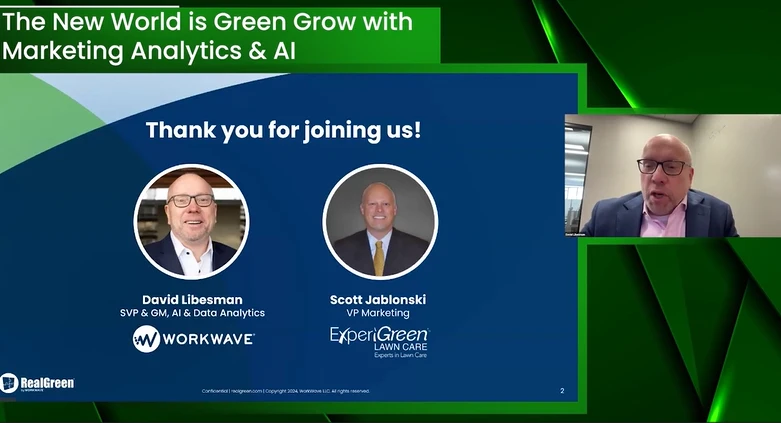
Information is power. (You’ve heard that before.) But when you can access real-time details regarding sales leads, labor hours and production status, you can make the type of just-in-time decisions that improve profitability.
This month, Lawn & Landscape spoke with three companies that shared what technology they use so they can be smarter about running their businesses.
Getting on track
Robert Groff was proud of the high-end residential landscapes that his company was completing. Groff Landscape Design was doing some interesting work. “We were doing cool projects and building a profit,” he says. “But we were losing money some years or breaking even.”
The numbers just weren’t adding up like Groff expected. “I was a typical contractor that tried to do everything in the beginning,” he says. Job costing and labor hour projections were sometimes off base.

So when Groff heard about a seminar led by Canada-based Landscape Management Network (LMN) for its budgeting and estimating software, he decided to check it out. The $100 fee was well worth the investment because it has changed the way Groff looks at numbers and tracks details.
“We can now estimate based off of a budget, which sounds elementary, but the software simplifies (the process) for you,” Groff says. Plus, it’s easy to use, he says. “It honestly reminds me of an Apple interface.”
Groff creates the annual budget, and all costs (direct, indirect) are logged into the system. He also enters into a database the cost for various materials, and there is a “portfolio” part of the program that allows him to create projects.
“Our process flows through this one integrated system. ... We figure out what the prospects’ needs are and how we can meet those and eventually (the lead) goes to a proposal stage.” Denny Langston, general manager and partner, Southern Scape
For example, the company has a “patio package” set up. “Once you enter the square footage, man-hours, pavers, gravel and other materials, you click and create an estimate,” Groff says.
Because the company’s budget is in the system, the software automatically adds the appropriate percentage of overhead recovery for labor, materials, equipment, etc. “That way, you are recovering all of your costs in a very strategic way,” Groff says.
The key is to input accurate information. Groff refers to previous profit-and-loss statements to help identify average costs.
As for labor hours, Groff uses a complementary tool called LMN Time. It basically allows his team to use their mobile phones to clock in and out of entire jobs, and components of every job. Because the team starts their days in the field versus office, this tool is especially helpful, Groff adds.
“When they get to the job site, they can log into LMN Time and note, ‘It’s 7 a.m. and we started installing the patio.’ And they can record, ‘It’s 11 a.m. and we are planting.’”
Not only does tracking hours motivate the crew – they can see their progress on jobs – but it also allows Groff to make real-time decisions and prevent leaching profit due to inaccurate labor hour estimates.
“If we see that we are over our hours, we’ll know right away and can find out how it happened and decide what to fix in the field so we hit our goals,” Groff says.
Go with the flow
How many leads does the sales team turn into opportunities? What’s the status of projects in the production process? How many (and which) jobs are closed out?
Many managers are so consumed by daily tasks that they bypass the big picture of the sales and production cycle. And, for lengthy jobs that require months to complete, there’s greater chance of losing track of time – and money.
At Southern Scape in Alabama, using Salesforce and its customer relationship management (CRM) tool has changed the way managers understand and react to information. “It helps us make on-the-fly adjustments,” says Denny Langston, general manager and partner.
For example, while installing a major landscape package at a commercial site, he reviewed tracked data and noticed labor overages, specifically with tree installation.
“There were hundreds of 2.5-inch caliper trees we were putting in and it was taking us, for whatever reason, too long compared to the estimate,” Langston says.
So, Langston reviewed the numbers with the production manager. “We made the decision to invest in an auger and start auguring instead of hand-digging holes to get our labor hours back in line,” he says.
Mid-project adjustments like this can make the difference between profit and loss.
Langston says Southern Scape opted for this technology when its consulting group introduced the platform. What’s attractive is how the program follows the company’s sales and production from beginning to end.
“Our process flows through this one integrated system,” Langston says.
Leads are inputted, along with all of their contact information. Once that lead progresses to an opportunity, the sales team tracks this and notes once that opportunity is qualified. “We figure out what the prospects’ needs are and how we can meet those and eventually (the lead) goes to a proposal stage,” he says.
A pricing tool helps with estimating, which is performed by an estimator who enters the “flow” at this point and inputs the scope of work and every step that must occur for the project to reach completion.
Projects move from account managers to project managers, who continue to use the system for tracking progress until the final walkthrough. “I can see what’s going on at any time and it’s real-time information,” Langston says.
Langston doesn’t want to micromanage his people. But he can stay involved by having the information and redirecting teams if and when necessary.
“Salesforce and the CRM allow us to hire people to do their jobs, and then step back and truly manage what is going on rather than being consumed by daily tasks,” he says.
Stepping up retention
“Did we talk about this last year?” an account manager might wonder when suggesting enhancements or potential projects on a property for the coming year. No one can remember every detail of every conversation, especially if a client has been on board for years.
That is, unless the team has information at their fingertips, says Jonathan Thrift, president of Carolina Creations Landscapes in Shallotte, North Carolina. Nine years ago, the company implemented Salesforce, but didn’t fully tap into the system’s potential. In the last five years, the company has ramped up its use and now it’s simply a part of how the team does business.
“You might as well embrace (technology). That’s the motto we have lived by. Use technology to the best of your ability and make it work for you.” Jonathan Thrift, Carolina Creations Landscape
Thrift says the client retention rate is a sign that the system is working. “We have always had good retention rates, but now we are seeing 95 to 98 percent retention, which is fantastic,” he says.
What’s more, client relationships are stronger, he adds. “We have two customer appreciation days a year, and I have seen more and more clients coming to those,” he says. “And, they know their account managers better.”
From a revenue perspective, the company has grown every year since it implemented the system. “I attribute that to Salesforce and being able to hold people accountable by using it,” Thrift says.
“If a client calls in, our office manager enters the information into the Salesforce client page and an email is sent to our sales rep,” Thrift says. “Account managers can look back and see a history of all phone calls, from meetings and proposals to offering work.”
That’s the “did I mention new plantings” conversation Thrift referred to earlier. “We’re not standing there wondering if we had the conversation before.”
Technology is here to stay, Thrift says. “You might as well embrace it,” he says. “That’s the motto we have lived by. Use technology to the best of your ability and make it work for you.”

Explore the November 2016 Issue
Check out more from this issue and find your next story to read.
Latest from Lawn & Landscape
- Ever-changing landscape of SEO
- Fleetio acquires Auto Integrate, raises $450M in Series D funding
- Davey Tree expands in St. Paul, promotes Ostlie to district manager
- Schill Grounds Management taps 3 for senior leadership roles
- HD Hyundai Construction Equipment North America adds to wheeled excavator lineup
- High maintenance
- From Design to Proposal: Estimating and Rendering Support Services
- PERC adds Joel Stutheit as senior manager of business development







